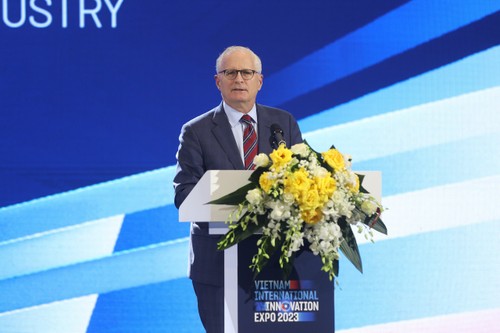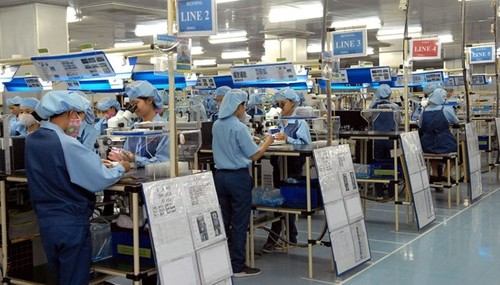 John Neuffer, President and CEO of the US Semiconductor Industry Association, speaks at Vietnam Semiconductor Summit in Hanoi on October 29, 2023. (Photo: TH) John Neuffer, President and CEO of the US Semiconductor Industry Association, speaks at Vietnam Semiconductor Summit in Hanoi on October 29, 2023. (Photo: TH) |
Bao Tram: Welcome to VOV English 24/7. Vietnam is now accelerating its efforts to develop the semiconductor industry, aiming to become one of the world’s semiconductor hubs. What do you think of the potential for Vietnam to develop this industry?
John Neuffer: I think the sky is the limit right now. There's a lot of chain rebalancing going on around the world. Everyone is trying to spread the risk. For example, there's probably too much manufacturing in Southeast Asia. 75% of those chips remain in East Asia. That's too concentrated. We need to do business in other parts of the world and, coming off the pandemic, we realize there's a lot of vulnerabilities and we need to spread our risks around more, more evenly. I think that creates a lot of potential for Vietnam. Vietnam has a really awesome workforce, a very hardworking workforce, a lot of STEM students being trained in Vietnam, but maybe not enough STEM students uniquely trained to work in our industry, so I think that needs to be improved.
Bao Tram: The Vietnamese government has adopted several policies and incentives to promote the semiconductor industry. Do you have any comment on those policies?
John Neuffer: First of all, it's very exciting that there is an interest from the very top of your government down. We hosted your Prime Minister last month in Washington at a round table, and we had a great discussion with our executive, so having strong political leadership to help guide Vietnam to be a bigger player in our semiconductor industry is very, very, very helpful. We're also very excited that Vietnam is putting together a Vietnam semiconductor strategy. And I know there are a lot of different incentive packages in place. The key thing for Vietnam is that it needs to look at what its competition is doing in other countries in terms of incentive packages and match it, and maybe do a little bit better.
Bao Tram: After this year's fact-finding tour of Southeast Asia, how interested are US semiconductor manufacturers in the Vietnamese semiconductor market?
John Neuffer: I can just tell you that Vietnam was very energized and enthusiastic and that made a very strong impression on all of us. So we came earlier this year. We're here again now and we're coming back again early next month. I'll add that Vietnam is already quite experienced in back-end assembly testing for the semiconductor industry. There's a number of players here that do that, including Intel and Amkor, but Vietnam should also be looking at the front-end, designing the chips, which it is already doing somewhat, but it can play a much stronger role there. A lot of potential there!
Bao Tram: What do you think Vietnamese businesses should do to attract resources, such as from the US?
John Neuffer: I think it’s not just businesses. I think it's universities and the government, too – universities providing more of the STEM talent that’s attractive to our industry, and government putting in place incentive packages, whether it's tax incentives or infrastructure incentives, that match or better what's happening with your competitors. I think all these things have to happen together.
Bao Tram: What has the US Semiconductor Industry Association done to encourage its members to invest in Vietnam?
John Neuffer: We are a resource, and we really enjoy our interactions with your government, which is very open-minded and hearing what our humble recommendations are. I think, as an association, that's the biggest thing we can do – act as a resource and help Vietnam’s industry, government, and universities go forward aggressively and try to become a bigger part of our supply chain.
 With many advantages, Vietnam is emerging as a key market for large global semiconductor manufacturers (Photo: VNA) With many advantages, Vietnam is emerging as a key market for large global semiconductor manufacturers (Photo: VNA) |
Bao Tram: To get involved in the whole process of making semiconductors, rather than just testing and packaging, do you think Vietnam should follow the model of other countries or should Vietnam find its own way?
John Neuffer: In the US we feel strongly that no country should try to have the full supply chain within its borders. Even we don't have that. For example, we have almost no back-end – test packaging. Countries need to look at where they're strong and seize that opportunity, and not try to do a bit of everything, because then you dilute your effectiveness. You should find out where you're strong and make it stronger. Typically what Vietnam is doing well is to take a small bite of the apple and gain a lot of experience, and once you understand the industry, you grow and become a bigger part of our supply chain.
Bao Tram: Do you have any more suggestions for expanding the Vietnamese semiconductor industry?
John Neuffer: So it was very important for the semiconductor industry to focus on what it's strong at, and it's already very strong at assembly test packaging, which is back-end. But the industry should also focus on the front-end design side of our industry. Some of that's already happening here, but there's a lot of potential. The great thing about the design side of our industry is you don't need the high cost of entry. If you want to put a fabrication facility in Vietnam, it's $10 billion, $20 billion. If you want to begin to get into the design, it will be much cheaper. Basically, you just need a keyboard, a computer, a 5G network, and an engineer to begin to design.
Bao Tram: Thank you for the interview. That was John Neuffer, President and CEO of the US Semiconductor Industry Association.
John Neuffer: Thank you. Very appreciative!
· The Vietnam Semiconductor Innovation Network made its debut on October 29, 2023, within the framework of the Vietnam Semiconductor Summit.
· Vietnam boasts reputable research and training institutions in semiconductors, including Hanoi National University, Ho Chi Minh City National University, Da Nang University, and Hanoi University of Science and Technology.
· Vietnam also has some large enterprises with the resources to help develop Vietnam’s semiconductor industry, including Viettel, VNPT, FPT, and CMC Corporation.
· Vietnam has been attracting more and more large semiconductor firms from the US, the Republic of Korea, Japan, and Europe.
· Vietnam’s model of a training and incubation center for semiconductor IC design combined with semiconductor training and research programs at its universities has been widely praised.
·